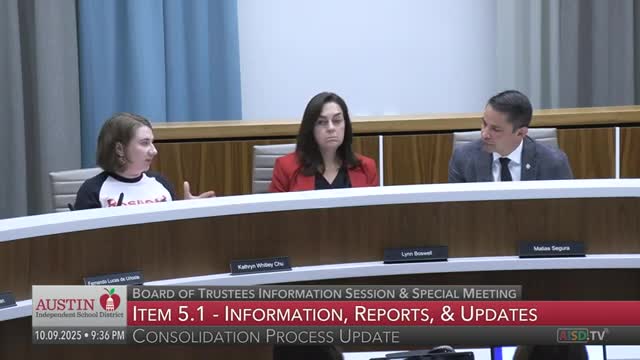Austin ISD reports small gains in third-grade math; trustees approve monitoring report and ask for continued investment
October 10, 2025 | AUSTIN ISD, School Districts, Texas
This article was created by AI summarizing key points discussed. AI makes mistakes, so for full details and context, please refer to the video of the full meeting. Please report any errors so we can fix them. Report an error »

The Austin ISD board unanimously accepted a monitoring report showing incremental gains in third‑grade math outcomes and pledged to continue investment in instructional materials, teacher coaching and leadership development.
District data presented to trustees showed 42% of third graders scored "meets grade level or above" on the STAR mathematics assessment in 2024–25, up from 39% the prior year. Administrators said the change correlates with a district focus on high‑quality math materials, coaching cycles and expanded observation and feedback for campus instructional leaders.
Doctor Mary Ann Maxwell, Assistant Superintendent of Academics, and Jennifer Jones, Director of Elementary STEM, described the district’s approach as threefold: adopt high-quality instructional materials aligned to conceptual and procedural rigor; build teacher content knowledge and coaching cadence; and prioritize targeted supports for campus leaders and high‑need schools. Examples cited included use of STEMScopes curriculum, expanded professional learning days, and Lighthouse Schools and Learning Labs coaching cohorts that bring groups of campuses together to learn and practice instructional routines.
Administrators highlighted several schools that exceeded district averages or demonstrated significant year‑to‑year growth — Galindo, Blackshear, Campbell, Palm and Zavala — and attributed gains to consistent use of adopted curriculum, weekly PLCs, prioritized coaching and small-group intervention blocks. Victoria O’Neil (Enrollment/Campus Family Engagement) and Jennifer Pace (Assistant Superintendent of Elementary Schools) described a model that pairs Lighthouse coaching cohorts with monthly leadership calibration to help replicate best practices across clusters of campuses.
Trustees pressed for clarity on scale and sustainability: how Lighthouse coaching will be embedded in district systems, how the district will maintain supports given recent central-office restructurings, and how the district will ensure the same instructional expectations are met across campuses and grade levels. Administrators said Lighthouse is intended to build district capacity; the external partner’s practices are being internalized so district teams can sustain coaching over time.
The board moved to accept the monitoring report; the motion passed unanimously. Trustees asked the administration to continue publishing progress measures, provide data disaggregated by student groups and campus, and prioritize resources for the highest‑need campuses to close persistent gaps.
District data presented to trustees showed 42% of third graders scored "meets grade level or above" on the STAR mathematics assessment in 2024–25, up from 39% the prior year. Administrators said the change correlates with a district focus on high‑quality math materials, coaching cycles and expanded observation and feedback for campus instructional leaders.
Doctor Mary Ann Maxwell, Assistant Superintendent of Academics, and Jennifer Jones, Director of Elementary STEM, described the district’s approach as threefold: adopt high-quality instructional materials aligned to conceptual and procedural rigor; build teacher content knowledge and coaching cadence; and prioritize targeted supports for campus leaders and high‑need schools. Examples cited included use of STEMScopes curriculum, expanded professional learning days, and Lighthouse Schools and Learning Labs coaching cohorts that bring groups of campuses together to learn and practice instructional routines.
Administrators highlighted several schools that exceeded district averages or demonstrated significant year‑to‑year growth — Galindo, Blackshear, Campbell, Palm and Zavala — and attributed gains to consistent use of adopted curriculum, weekly PLCs, prioritized coaching and small-group intervention blocks. Victoria O’Neil (Enrollment/Campus Family Engagement) and Jennifer Pace (Assistant Superintendent of Elementary Schools) described a model that pairs Lighthouse coaching cohorts with monthly leadership calibration to help replicate best practices across clusters of campuses.
Trustees pressed for clarity on scale and sustainability: how Lighthouse coaching will be embedded in district systems, how the district will maintain supports given recent central-office restructurings, and how the district will ensure the same instructional expectations are met across campuses and grade levels. Administrators said Lighthouse is intended to build district capacity; the external partner’s practices are being internalized so district teams can sustain coaching over time.
The board moved to accept the monitoring report; the motion passed unanimously. Trustees asked the administration to continue publishing progress measures, provide data disaggregated by student groups and campus, and prioritize resources for the highest‑need campuses to close persistent gaps.
View the Full Meeting & All Its Details
This article offers just a summary. Unlock complete video, transcripts, and insights as a Founder Member.
✓
Watch full, unedited meeting videos
✓
Search every word spoken in unlimited transcripts
✓
AI summaries & real-time alerts (all government levels)
✓
Permanent access to expanding government content
30-day money-back guarantee

